|
MESSAGE BOARD |
EMAIL ME |
HOMEPAGE |
INTRODUCTION |
TRACED |
LOST FRIENDS |
EVENTS |
GROUP PHOTOS |
ALBUM INDEX |
RINGWAY |
SERVICE RECORDS |

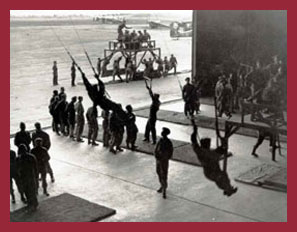
| Before making any parachute descent, pupils at the PTS were introduced to carefully devised pre-jump routines. `Synthetic' ground training using all manner of contraptions and devices originally set up at Ringway purely for the lack of training aircraft for making actual parachute descents. The renowned circus-master of the Ringway Hangars was Wing Commander J C Kilkenny OBE and the fact that RAF ground training methods have changed little in over 60 years is a tribute to this officer's ingenuity and foresight. |
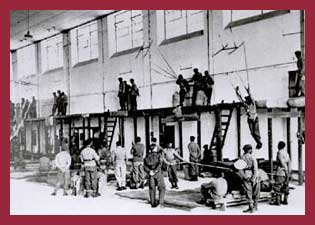 |
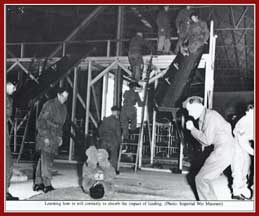
Click here for an enlarged picture | RAF instructors taught the trainee parachutists how to exit correctly from an aircraft, how to control his parachute in the air and how to land correctly. Fuselages of Whitleys and Dakotas were positioned in the hangars at Ringway and from these trainees jumped whilst learning the correct position for an exit. Other training aids included trapezes, in which the trainees swung whilst learning correct flight drills, and wooden chutes down which they slid before falling and rolling. Not surprisingly the crux of the matter was developing a head for heights and the 'Fan', consisted of a drum around which was wound a steel cable, the end of which was attached to a parachute harness. When the trainee jumped from a platform twenty feet from the ground, his weight caused the drum to revolve; however, its speed was controlled by two vanes which acted as air brakes and thus allowed the trainee to land with the same impact as he would when using a parachute. |
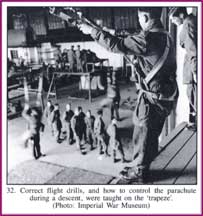
Click here for an enlarged picture |

|
Another piece of training apparatus was a one hundred foot tower constructed of steel girders from the top of which protruded a long steel arm. Suspended from the'Tower' by a cable was a
parachute canopy stretched across a large metal hoop. On launching himself from the tower on the command 'Go' the trainee
found himself suspended in mid-air beneath the canopy. After he practised his flight drills and adopted the correct position for landing,
the cable was released and he floated to the ground. This provided the pupil with a real test of nerve before attempting his first
free parachute descent. |
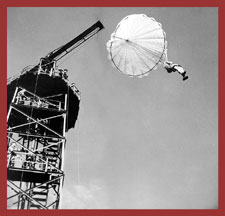
Click here for an enlarged picture |
NEXT PAGE |